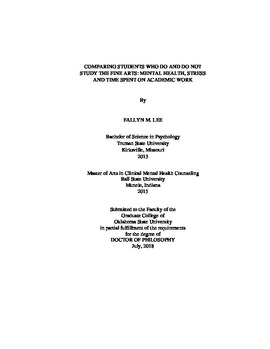| dc.description.abstract | Historic research has supported the claim that artists experience higher rates of mental illness than those who do not engage in the creative arts (Andreasen, 1987; Kyaga et al., 2011; Richards, Kinney, Lunde, Benet, & Merzel, 1988; Santosa et al., 2007; Sass, 2000). Recent research contradicts these sweeping assumptions, but still finds some support that artists have higher rates of mental illness and stress (Elias & Berg-cross, 2009; Greason, Glaser & Mroz, 2015; Young, Winner, & Cordes, 2013). College students' experiences of stress and mental illness are well documented throughout research (Archer & Lamnin, 1985; Beiter et al., 2015; Leppink et al., 2016; Murphy & Archer, 1996). Researchers do not understand the role that time spent on demanding majors, such as the fine arts, plays in stress and mental health of college students. This study attempted to fill the gaps in the research by investigating potential differences between college students studying the fine arts and those who do not with regard to overall mental health, stress, and time spent on academic work. A total of 66 students, 33 collegiate artists and 33 non artists, from a large, Midwestern university were surveyed on mental health, stress, and time spent on academic work. Two one-way ANOVAs were used to investigate potential differences in mental health as measured by the Outcome Questionnaire 45.2 and stress as measured by the Perceived Stress Scale. Neither model was significant and there were no significant differences between groups in overall mental health (F (1,64) = 1.701, p = .197) or stress (F (1, 64) = 1.679, p = .200). A one-way MANOVA analysis was used to assess time spent on academic work and the model was found to be significant (F (4, 64) = 2.917), p = .021). These findings suggest that although there were no statistically significant differences between artists and their non-artistic peers in mental health and stress, these groups did spend different amounts of time on academic work. Implications and limitations to the study are discussed. | |
